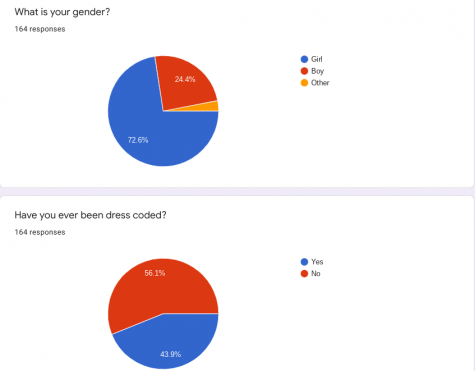In 1968, the U.S. The Supreme Court ruled on a case regarding a dress code. The ruling was put into place so students in Des Moines, Iowa could not wear black armbands in protest of the Vietnam War. The students argued that the clothing was an expression of free speech.
The First Amendment states that all US citizens have the right of free speech and expression. Do school dress codes take away that freedom? Or are they placed in order to keep a focused learning environment? And if both are true, then which is more important?
Dress codes have historically targeted the female population rather than male. One example was at Tottenville High School in New York, where over 200 students were sent to detention (the majority being girls) for 2 weeks, just for violating the school dress code. Many of the clothing banned by the school’s dress code were items primarily worn by girls.
There is a clear reason for this that has already been understood by most. Boys tend to not wear anything that would be considered ‘distracting.’ Girls tend to express more with clothing than boys; although that is true, there is still a big issue to address.
The narrative that girls need to cover up so boys won’t get sidetracked is inequitable. This portrayal implies that it is the girl’s fault for having a body around the opposite gender. Rather than covering up with a sweatshirt, boys and girls should be taught how to respect themselves and each other.
Boys getting “distracted” by shoulders and bra straps is an excuse for immaturity. Male students can control themselves, saying otherwise is condescending. Boys should be able to handle themselves just as girls should be able to do.
There are some positives to a dress code. Some studies show that students with a dress code may do better in school. In 2000, the New York Police Department conducted a survey about the new dress code uniforms that had been put into place. According to Larry Wilder and Scott Key of Fresno Pacific University, 68% of the parents believed that their child was improving academically with the new uniforms.
Another argument for dress codes is that wearing certain clothes are just completely inappropriate for a school setting, which is somewhat true.
There is a line that shouldn’t be crossed; students shouldn’t show up to class in underwear. Some shorts may be no different than a bikini bottom. Still, students should not be humiliated for wearing casual clothing.
Some clothes are made for a sexual manner. However, simply showing shoulders or wearing shorts that go higher than your arm’s length is not sexual. Schools need to learn how to navigate the subtlety of a true distraction versus unwarranted shaming.
I tried looking for statistics on the percentage of girls and boys that get dress coded, but everything I found was either unreliable or outdated. Therefore, I created my own statistics by creating an online form asking teenagers questions about their experiences with dress code.
I received over 160 responses in under two days from all over the country. Kitsap teenagers made up 82% of the respondents. The participants consisted of 72.6% females, 24.4% males and 3% that identified as another gender.

The majority (56.1%) of respondents said they have not been dress coded, but 43.9% reported that they have. 79.3% of the respondents stated they knew a female peer that has been dress coded, 3.7% said they knew a boy, 11% said they knew no one that has, 4% said they knew people of both sexes that have been dress coded.

This number is far too high.
When it comes down to it, dress codes are sexualizing minors. In 2017, Samantha Parsons put together “a dress code advocacy guide.” She found that dress codes strengthen the ideas that objectify women and that what they choose to wear causes them to be victims of sexual harassment or assault.
The human body is not inherently shameful unless you make it so. Skin and bodies are natural and children should not be ridiculed for it.
When it comes to dress codes, the risk to benefit ratio is not even. Dress codes suggest sexist messages that can leave permanent impact to students as they become adults. Dress codes for casual clothing are unnecessary and have more negative impacts than positives.











